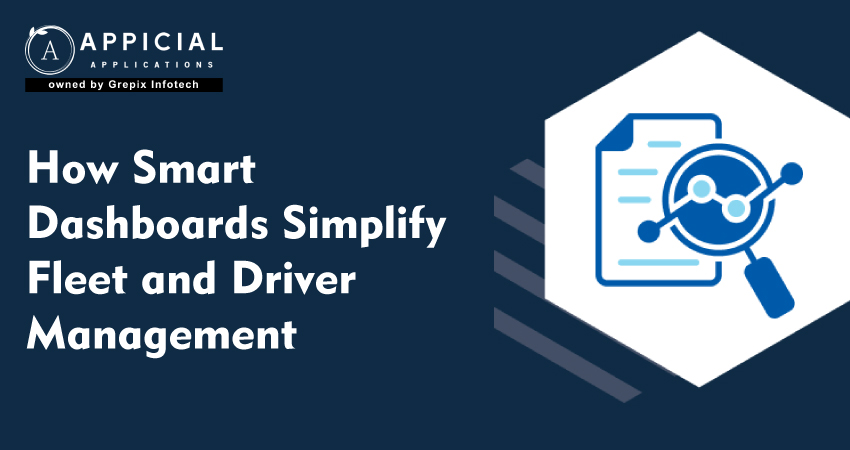
How Smart Dashboards Simplify Fleet and Driver Management
Managing a fleet of vehicles and a large driver base presents major operational challenges. A ride-sharing app or Uber Clone must coordinate thousands of trips, monitor driver activity, optimise routes, control costs, and maintain service quality. Manual spreadsheets or disconnected systems fail to deliver the required visibility. A well-designed white-label taxi booking app from a trusted taxi app development company must include smart dashboards. These dashboards bring data together into clear visuals. They allow operations managers to monitor vehicle utilisation, driver performance, idle time, maintenance needs and route efficiency in real time.
The global fleet management market is projected to grow from USD 32.2 billion in 2025 to USD 153.7 billion by 2035 at a CAGR of 16.9%. This rapid growth underscores how critical analytics and dashboards have become. For an Uber Clone, adopting dashboard-centric control becomes a differentiator. For a white label taxi app development company, embedding these tools into your platform ensures you deliver a scalable, controllable solution.
In the sections ahead, we examine the value of smart dashboards, their key components, how they drive actionable insights, and why your business needs them now.
This blog details how smart dashboards simplify fleet and driver management for a ride-hailing business. It explains why a Uber Clone or ride-sharing app needs a central dashboard. It describes how a white-label taxi booking app, provided by a taxi app development company, integrates these dashboards. It highlights features, metrics, real-time insights and driver/fleet workflows. It promotes Appicial Applications as the ideal partner and concludes with a clear CTA.
What key dashboard features should a ride-sharing app include?
When building a ride-sharing app or Uber Clone on a white-label taxi booking app, your dashboards must include specific features. Here are major elements:
- Real-time vehicle map view: Shows every active vehicle’s location, status (on-trip, idle, maintenance), driver assignment and route progress.
- Driver performance tiles: Displays for each driver metrics such as acceptance rate, cancellation count, rides per hour, rating, earnings.
- Fleet utilisation summaries: Highlights percentage of vehicles active, idle, under maintenance, or offline.
- Key operational alerts: Automated triggers for high idle time, repeated cancellations, route delays, maintenance overdue.
- Maintenance and health monitoring: Tracks vehicle age, last service date, upcoming inspections, fault alerts.
- Cost and revenue dashboards: Compares revenue per vehicle, cost per kilometre, driver earnings, fuel/EV use, idle cost.
- Time-block summaries and heat maps: Displays peak hours, demand zones, idle hotspots, supply-demand imbalances.
These features allow the operations team of a ride-sharing app built by a taxi app development company to act fast, allocate resources wisely, and reduce waste. The inclusion of these features in a white-label taxi booking app accelerates deployment and avoids building from scratch.
How do smart dashboards drive operational efficiency?
Smart dashboards transform raw data into operational decisions in a Uber Clone or ride-sharing app environment. Their value shows in multiple areas:
- Reduced idle time: Dashboards reveal when and where vehicles sit idle. You can then reposition vehicles or drivers proactively.
- Optimised driver assignment: By monitoring driver metrics, you can allocate better-performing drivers to high-demand zones. This improves matching and service levels.
- Improved maintenance scheduling: Dashboards show vehicle health metrics. You can schedule preventive maintenance before costly breakdowns occur, reducing downtime.
- Demand-supply balancing: Heat maps and utilisation metrics help you align driver supply with ridership demand zones and time blocks, reducing wait times and increasing utilisation.
- Performance benchmarking: You can compare drivers and vehicles across time periods and geographies. Identify top performers and those needing support.
- Cost control: Cost panels in dashboards show hidden expenses like fuel waste, long idle km, unnecessary detours. You act quickly to curb those.
For a white-label taxi booking app, these dashboard-driven efficiencies mean your taxi app development company delivers a platform with built-in operational control. You don’t just book rides, you manage fleets and drivers proactively.
Why is real-time data essential in driver and fleet management?
In a ride-sharing app or Uber Clone, lagging data is ineffective. Real-time dashboards make the difference.
- When a vehicle deviates from the allocated route, you see it immediately.
- When a driver cancels repeatedly, you spot the pattern quickly.
- When a zone sees high idle vehicles and low bookings, you identify the imbalance and shift resources.
According to recent industry data, the fleet management software solutions segment grew fastest in 2024 because operators demanded real-time tracking, route optimisation and data analytics. With a real-time dashboard embedded in your white-label taxi booking app, the taxi app development company ensures you gain live insights rather than after-the-fact reports. That allows you to make decisions when they matter, not hours or days later.
What metrics matter most for smart dashboards in ride-hailing?
In a Uber Clone or ride-sharing app, the right metrics steer performance. A white-label taxi booking app should surface these measures. Key metrics include:
- Rides per driver per hour: Higher numbers indicate efficient driver dispatch and demand match.
- Idle kilometres per vehicle: Lower values signal better utilisation of fleet assets.
- Vehicle utilisation rate: Percent of time each vehicle is engaged in paid trips, not waiting.
- Driver cancellation/decline rate: Excessive cancellations hurt service quality and raise cost.
- Average trip duration and distance: These numbers help detect inefficiencies or detoured routes.
- Maintenance downtime per vehicle: Minimising downtime enhances availability.
- Cost per kilometre and revenue per kilometre: Tracking economics of each vehicle helps you prune loss-making assets.
- Driver rating and rider satisfaction score: These affect retention, reputation and repeat usage.
In practice, the fleet management market’s growth (to USD 153.7 billion by 2035) shows how data-driven metrics and dashboards are becoming mainstream. A taxi app development company that builds a white-label taxi booking app with these metrics and dashboard views enables your platform to manage drivers and vehicles not just reactively, but proactively.
What role does analytics play in smart dashboards?
Smart dashboards do more than present data. Analytics powers them. For your ride-sharing app or Uber Clone, analytics layers add value:
- Trend detection: Dashboards show whether idle time is increasing in certain zones over weeks. Analytics surface those patterns.
- Predictive alerts: Analytics predict which drivers may drop off or which vehicles may require maintenance soon. Dashboards display alerts.
- Driver segmentation: Analytics group drivers by performance metrics, helping you tailor incentives or training programs.
- Route optimisation suggestions: Analytics feed dashboards with route suggestions or dispatch shifts to improve fleet-level efficiency.
- What-if simulations: Dashboards can visualise scenarios — e.g., increase vehicles by 10% in zone A — and show projected utilisation gain.
These capabilities come built into a reliable white-label taxi booking app when offered by a top-tier taxi app development company. Analytics-driven dashboards elevate your platform from booking system to intelligent operations hub.
How do dashboards support driver engagement and retention?
- Transparent performance feedback: Drivers can view their own dashboards, understand their metrics, see how they compare with peers.
- Incentive tracking: Dashboards show which milestones drivers qualify for, e.g., “Complete 30 rides this week for bonus”.
- Fair dispatching: If admin sees inequities in ride allocation, you can correct via dashboard insights, boosting driver fairness and morale.
- Training opportunities: Dashboard data identifies drivers with declining ratings or higher cancellations. You can intervene with coaching.
- Recognition of top performers: Dashboards highlight high-achieving drivers. Recognition fosters retention and performance.
When your white-label taxi booking app includes driver-facing dashboards, your taxi app development company equips you to engage drivers rather than just manage them. That supports service quality and long-term platform growth.
Learn More: How Centralized Admin Control Prevents Fraud and Operational Losses
Why should you partner with a white-label taxi app development company for dashboard capabilities?
Building a ride-sharing app or Uber Clone from scratch is time-consuming and risky. Partnering with a strong taxi app development company offers advantages:
- You launch faster: With a tested white-label taxi booking app that already includes smart dashboards and analytics.
- Domain expertise: The vendor brings knowledge in fleet and driver management — you avoid reinventing the wheel.
- Ongoing updates: Dashboard features evolve with market demands. A good partner ensures you stay ahead.
- Scalable architecture: As you grow across cities or vehicle types, your dashboard scales with you.
- Focus on business, not infrastructure: You concentrate on rider acquisition and growth, while the vendor supplies the operational backbone.
Selecting a white-label partner that emphasises dashboard features places your ride-sharing app in a stronger competitive position. The correct taxi app development company becomes your launchpad for smart fleet management, rather than just a booking engine vendor.
Conclusion
Smart dashboards are no longer optional for a modern ride-sharing app or Uber Clone. They provide the operational visibility, analytics and control needed to manage fleets and drivers effectively. These dashboards reduce idle time, improve utilisation, enhance driver performance, optimise costs and elevate service quality. When embedded in a robust white-label taxi booking app from a capable taxi app development company, dashboards change your platform from a dispatcher to a data-driven operations engine. For businesses looking to launch or scale a ride-hailing platform, Appicial Applications stands out.
As a leading taxi app development company, Appicial Applications offers a fully integrated white-label solution featuring smart dashboards, real-time analytics, driver performance modules and fleet management controls. They deliver both the technology and operational best practices you need. Call to Action: Connect with Appicial Applications today.
Request a demo of the dashboard suite in their white-label taxi booking app. See how your ride-sharing business can manage fleets better and drive growth smartly. Don’t settle for a basic booking app. Choose a partner that delivers operational excellence and scalability.
FAQs
Author's Bio

Vinay Jain is the Founder at Grepix Infotech and brings over 12 years of entrepreneurial experience. His focus revolves around software & business development and customer satisfaction.
Back to blog list




